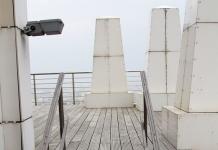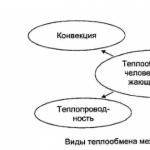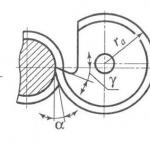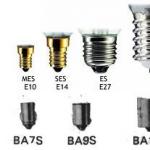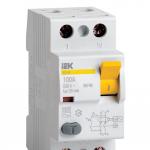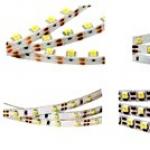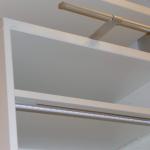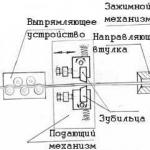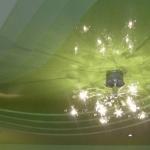A thyristor is a semiconductor device designed to act as a key. It has three electrodes and a p-n-p-n structure of four semiconductor layers. The electrodes are referred to as the anode, cathode and control electrode. The p-n-p-n structure is functionally similar to a non-linear resistor, which is capable of taking two states:
- with very high resistance, off;
- with very little resistance.
Kinds
On the included thyristor, a voltage of about one or several volts is stored, which increases slightly with increasing current flowing through it. Depending on the type of current and voltage applied to an electrical circuit with a thyristor, one of the three modern varieties of these semiconductor devices is used in it. Work on direct current:
- included trinistors;
- three types of lockable thyristors, referred to as
Triacs work on alternating and direct current. All these thyristors contain a control electrode and two other electrodes through which the load current flows. For trinistors and lockable thyristors, these are the anode and cathode; for triacs, the name of these electrodes is due to the correct determination of the properties of the control signal applied to the control electrode.

The presence of a p-n-p-n structure in the thyristor makes it possible to conditionally divide it into two regions, each of which is a bipolar transistor of the corresponding conductivity. Thus, these interconnected transistors are the equivalent of a thyristor, which looks like the circuit in the image on the left. Trinistors were the first to appear on the market.
Properties and characteristics
In fact, this is an analogue of a self-locking relay with one normally open contact, the role of which is played by a semiconductor structure located between the anode and cathode. The difference from a relay is that for this semiconductor device several methods of switching on and off can be applied. All these methods are explained by the transistor equivalent of the trinistor.
Two equivalent transistors are covered by positive feedback. It greatly amplifies any current changes in their semiconductor junctions. Therefore, there are several types of influence on the electrodes of the trinistor to turn it on and off. The first two methods allow you to turn on the anode.
- If the voltage at the anode is increased, at its certain value, the effects of the beginning breakdown of the semiconductor structures of transistors will begin to affect. The initial current that appears will be avalanche-like increased by positive feedback and both transistors will turn on.
- With a sufficiently rapid increase in the voltage at the anode, the interelectrode capacitances that are present in any electronic components are charged. At the same time, charging currents of these capacities appear in the electrodes, which are picked up by positive feedback and everything ends with the switching on of the trinistor.
If there are no voltage changes listed above, the turn-on usually occurs with the base current of the equivalent n-p-n transistor. You can turn off the trinistor in one of two ways, which also become clear due to the interaction of equivalent transistors. Positive feedback in them operates, starting with some values of currents flowing in the p-n-p-n structure. If the current value is made less than these values, positive feedback will work for the rapid disappearance of currents.
Another way to turn off is to interrupt the positive feedback with a voltage pulse that reverses the polarity at the anode and cathode. With such an impact, the direction of the currents between the electrodes is reversed and the trinistor is turned off. Since the phenomenon of the photoelectric effect is characteristic of semiconductor materials, there are photo- and optothyristors, in which the inclusion may be due to the illumination of either the receiving window or the LED in the case of this semiconductor device.
There are also so-called dinistors (uncontrolled thyristors). In these semiconductor devices, there is no control electrode constructively. At its core, this is a trinistor with one missing output. Therefore, their state depends only on the voltage of the anode and cathode, and they cannot be switched on by a control signal. Otherwise, the processes in them are similar to conventional trinistors. The same applies to triacs, which are essentially two trinistors connected in parallel. Therefore, they are used to control alternating current without additional diodes.
Lockable thyristors

If in a certain way to make areas of the p-n-p-n structure near the bases of equivalent transistors, it is possible to achieve complete controllability of the thyristor from the side of the control electrode. This construction of the p-n-p-n structure is shown in the image on the left. Such a thyristor can be turned on and off by appropriate signals at any time by applying them to the control electrode. The rest of the switching methods applied to trinistors are also suitable for lockable thyristors.
However, these methods do not apply to such semiconductor devices. On the contrary, they are excluded by certain circuit solutions. The goal is to achieve reliable switching on and off only by the control electrode. This is necessary for the use of such thyristors in high-power high-frequency inverters. GTOs operate at frequencies up to 300 Hertz, while IGCTs are capable of significantly higher frequencies, up to 2 kHz. The nominal values of currents can be several thousand amperes, and the voltage can be several kilovolts.
A comparison of various thyristors is shown in the table below.
| Kind of thyristor | Advantages | Flaws | Where is used |
| Trinistor | The minimum voltage in the on state at the highest possible currents and overloads. The most reliable of all. Good circuit scalability by working together multiple trinistors connected either in parallel or in series | There is no possibility of arbitrary controlled shutdown only by the control electrode. The lowest operating frequencies. | Electric drives, high power power supplies; welding inverters; control of powerful heaters; static compensators; switches in AC circuits |
| GTO | Possibility of arbitrary controlled shutdown. Relatively high overcurrent capability. The ability to work reliably with a serial connection. Operating frequency up to 300 Hz, voltage up to 4000 V. | Significant voltage in the on state at the highest possible currents and overloads and the corresponding losses, including those in control systems. Complex circuitry for building the system as a whole. Large dynamic loss. | |
| IGCT | Possibility of arbitrary controlled shutdown. Relatively high overcurrent capability. Relatively low voltage in the on state at the highest possible currents and overloads. Operating frequency - up to 2000 Hz. Simple control. The ability to work reliably with a serial connection. | The most expensive of all thyristors | Electric drives; static reactive power compensators; high power power supplies, induction heaters |
Thyristors are manufactured for a wide range of currents and voltages. Their design is determined by the size of the p-n-p-n structure and the need to obtain reliable heat removal from it. Modern thyristors, as well as their designations on electrical circuits, are shown in the images below.
In order to clearly imagine the work, it is necessary to give an idea of the essence of the work of the thyristor.
Controlled conductor consisting of four P-N-P-N semiconductor junctions. Its principle of operation is similar to that of a diode and is carried out when an electric current is supplied to the control electrode.
The passage of current through the thyristor is possible only if the anode potential is higher than the cathode potential. The current through the thyristor stops passing when the current value drops to the closing threshold. The current that enters the control electrode does not affect the current in the main part of the thyristor and, in addition, it does not need constant support in the ground state of the thyristor, it is necessary only to open the thyristor.
There are several decisive characteristics of a thyristor
In the open state, favorable for the conductive function, the thyristor is characterized by the following indicators:
- Voltage drop, it is defined as a threshold voltage using internal resistance.
- Maximum allowable current up to 5000 A, rms value, typical for the most powerful components.
In the locked state of the thyristor, this is:
- Direct maximum allowable voltage (higher than 5000A).
- In general, the forward and reverse voltage values are the same.
- Blocking time or time with a minimum value during which the thyristor is not influenced by the positive value of the anode voltage relative to the cathode, otherwise the thyristor will spontaneously unlock.
- The control current inherent in the open main part of the thyristor.
There are thyristors designed for low frequency circuits and high frequency circuits. These are the so-called high-speed thyristors, their scope is designed for several kilohertz. High-speed thyristors are characterized by the use of unequal forward and reverse voltages.
To increase the constant voltage value

Rice. No. 1. Overall and connecting dimensions and drawing of the thyristor. m 1, m 2 - control points at which the pulse voltage is measured during the open state. L 1 min - the smallest air gap (distance) in the air between the leads of the anode and the control electrode; L 2 min – minimum distance current passage length leaks between conclusions.
Varieties of thyristors
- - diode thyristor, has two outputs an anode and a cathode.
- Trinistor - a triode thyristor is equipped with an additional control electrode.
- A triac is a symmetrical thyristor, it is an anti-series connection of thyristors, it has the ability to pass current in the forward and reverse directions.

Rice. No. 2. Structure (a) and current-voltage characteristic (CVC) of the thyristor.
Thyristors are designed to work in circuits with different frequency limits, in a common application, thyristors can be connected to diodes, which are connected in an opposite way, this property is used to increase the constant voltage that the component can withstand in the off state. For advanced circuits, use thyristorGTO (gate turn oee - lockable thyristor), it is completely controllable. Its locking occurs along the control electrode. The use of thyristors of this kind has found application in very powerful converters, since it can pass high currents.
Write comments, additions to the article, maybe I missed something. Take a look at , I will be glad if you find something else useful on mine.
Thyristor. Device, purpose.
A thyristor is a controlled three-electrode semiconductor device with three p–n-transitions, which has two stable states of electrical equilibrium: closed and open.
The thyristor combines the functions of a rectifier, a switch and an amplifier. Often it is used as a regulator, mainly when the circuit is powered by an alternating voltage. The following points reveal the three main properties of a thyristor:
1 a thyristor, like a diode, conducts current in one direction, acting as a rectifier;
2 the thyristor is switched from off to on when a signal is applied to the control electrode and, therefore, as a switch has two stable states.
3 the control current required to transfer the thyristor from the "closed" state to the "open" state is much less (several milliamps) at an operating current of several amperes and even several tens of amperes. Therefore, the thyristor has the properties of a current amplifier;
Device and main types of thyristors
Rice. 1. Thyristor circuits: a) Main four-layer p-n-p-n-structure b) Diode thyristor c) Triode thyristor.
The main scheme of the thyristor structure is shown in fig. 1. It is a four-layer semiconductor structure p-n-p-n, containing three series-connected pn-transition J1, J2, J3. Contact to external p-layer is called the anode, to the outer n-layer - cathode. In general p-n-p-n- the device can have up to two control electrodes (bases) attached to the inner layers. By applying a signal to the control electrode, the thyristor is controlled (its state changes). A device without control electrodes is called diode thyristor or dinistor. Such devices are controlled by a voltage applied between the main electrodes. A device with one control electrode is called triode thyristor or trinistor(sometimes just a thyristor, although this is not entirely correct). Depending on which layer of the semiconductor the control electrode is connected to, trinistors are controlled by the anode and by the cathode. The latter are the most common.
The devices described above come in two varieties: passing current in one direction (from the anode to the cathode) and passing current in both directions. In the latter case, the corresponding devices are called symmetrical(because their CVC is symmetrical) and usually have a five-layer semiconductor structure. Symmetrical trinistor also called triac or triac(from English triac). It should be noted that instead of symmetrical dinistors, their integral analogues with better parameters are often used.
Thyristors with a control electrode are divided into lockable and non-lockable. Non-shutoff thyristors, as the name implies, cannot be turned off by a signal applied to the control electrode. Such thyristors close when the current flowing through them becomes less than the holding current. In practice, this usually occurs at the end of the half-wave of the mains voltage.
Thyristor current-voltage characteristic

Rice. 2. Current-voltage characteristic of the thyristor
A typical CVC of a thyristor that conducts in one direction (with or without control electrodes) is shown in Figure 2. It has several sections:
· Between points 0 and (Vvo, IL) there is a section corresponding to the high resistance of the device - direct blocking (lower branch).
· At point Vvo, the thyristor is turned on (the switching point of the dinistor to the on state).
· Between the points (Vv, IL) and (Vn, In) there is a section with a negative differential resistance - an unstable region of switching to the on state. When applying the potential difference between the anode and cathode of the direct polarity thyristor is greater than Vno, the thyristor is unlocked (dinistor effect).
The section from the point with coordinates (Vn, In) and above corresponds to the open state (direct conduction)
The graph shows the I–V characteristics with different control currents (currents on the control electrode of the thyristor) IG (IG=0; IG>0; IG>>0), and the greater the current IG, the lower the voltage Vbo, the thyristor switches to a conducting state
· The dotted line indicates the so-called. “rectification turn-on current” (IG>>0), at which the thyristor goes into a conducting state at a minimum anode-cathode voltage. In order to transfer the thyristor back to a non-conducting state, it is necessary to reduce the current in the anode-cathode circuit below the rectification turn-on current.
· The section between 0 and Vbr describes the device's reverse locking mode.
The current-voltage characteristic of symmetric thyristors differs from that shown in fig. 2 by the fact that the curve in the third quarter of the graph repeats sections 0-3 symmetrically with respect to the origin.
According to the type of nonlinearity of the CVC, the thyristor is classified as an S-device.
Thyristors are a type of semiconductor device. They are designed for regulation and switching of high currents. The thyristor allows you to switch the electrical circuit when a control signal is applied to it. This makes it look like a transistor.
As a rule, a thyristor has three outputs, one of which is control, and the other two form a path for the flow of current. As we know, the transistor opens in proportion to the magnitude of the control current. The larger it is, the more the transistor opens, and vice versa. But the thyristor is arranged differently. It opens completely, spasmodically. And what is most interesting, it does not close even in the absence of a control signal.
Operating principle
Consider the operation of a thyristor according to the following simple scheme.
A light bulb or LED is connected to the anode of the thyristor, and the positive output of the power source is connected to it through switch K2. The thyristor cathode is connected to the negative power supply. After the circuit is turned on, the thyristor is energized, but the LED is off.

If you press the K1 button, the current through the resistor will go to the control electrode, and the LED will start to glow. Often on the diagrams it is denoted by the letter "G", which means gate, or in Russian the shutter (control output).
The resistor limits the control output current. The minimum operating current of this considered thyristor is 1 mA, and the maximum allowable current is 15 mA. With this in mind, in our circuit, a resistor with a resistance of 1 kOhm was selected.
If you press the K1 button again, then this will not affect the thyristor, and nothing will happen. To transfer the thyristor to the closed state, you need to turn off the power switch K2. If power is applied again, the thyristor will return to its original state.
This semiconductor device, in fact, is a latching electronic key. The transition to the closed state also occurs when the supply voltage at the anode decreases to a certain minimum, approximately 0.7 volts.
Device Features
Fixing the on state occurs due to the peculiarities of the internal structure of the thyristor. An example diagram looks like this:

Usually it is presented in the form of two transistors of different structures, interconnected. Empirically, you can check how transistors connected according to this scheme work. However, there are differences in the current-voltage characteristic. And you also need to consider that the devices were originally designed to withstand high currents and voltages. On the case of most of these devices there is a metal outlet on which a radiator can be fixed to dissipate heat energy.

Thyristors are made in various cases. Low-power devices do not have a heat sink. Common domestic thyristors are as follows. They have a massive metal case and withstand high currents.

Basic parameters of thyristors
- Maximum allowable forward current . This is the maximum value of the open thyristor current. In powerful devices, it reaches hundreds of amperes.
- Maximum allowable reverse current .
- forward voltage . This is the voltage drop at maximum current.
- reverse voltage . This is the maximum allowable voltage on the thyristor in the closed state, at which the thyristor can operate without violating its performance.
- Turn-on voltage . This is the minimum voltage applied to the anode. This refers to the minimum voltage at which the operation of the thyristor is generally possible.
- Minimum current of the control electrode . It is necessary to turn on the thyristor.
- Maximum admissible control current .
- Maximum allowable power dissipation .
Dynamic parameter
Thyristor transition time from closed to open state when a signal arrives.
Types of thyristors

According to the method of management, they are divided into:
- Diode thyristors, or otherwise dinistors. They are opened by a high voltage pulse that is applied to the cathode and anode.
- Triode thyristors, or trinistors. They are opened by the electrode control current.
Triode thyristors, in turn, are divided:
- Cathode control - the voltage that forms the control current is supplied to the control electrode and cathode.
- Anode control - control voltage is applied to the electrode and anode.
The thyristor is locked:
- Reducing the anode current - the cathode is less than the holding current.
- By applying a locking voltage to the control electrode.
By reverse conductivity, thyristors are divided:
- Reverse conductive - have a small reverse voltage.
- Reverse-non-conductive - the reverse voltage is equal to the highest forward voltage in closed form.
- With a non-standard reverse voltage value - manufacturers do not determine the value of this value. Such devices are used in places where reverse voltage is excluded.
- Triac - passes currents in two directions.
Using triacs, you need to know that they operate conditionally symmetrically. The main part of the triacs opens when a positive voltage is applied to the control electrode compared to the cathode, and any polarity can be on the anode. But if a negative voltage comes to the anode, and a positive voltage comes to the control electrode, then the triacs do not open, and can fail.
By speed divided by the time of unlocking (on) and the time of locking (off).
Separation of thyristors by power
When the thyristor operates in the key mode, the highest power of the switched load is determined by the voltage on the thyristor in the open form at the highest current and the highest power dissipation.
The effective value of the current to the load should not be higher than the maximum dissipated power divided by the open voltage.
Simple signaling based on thyristor
On the basis of a thyristor, you can make a simple alarm that will respond to light by making a sound using a piezo emitter. The control output of the thyristor is energized through a photoresistor and a tuning resistor. Light falling on the photoresistor reduces its resistance. And the unlocking current begins to flow to the control output of the thyristor, sufficient to open it. After that, the buzzer turns on.
The tuning resistor is designed to adjust the sensitivity of the device, that is, the response threshold when irradiated with light. The most interesting thing is that even in the absence of light, the thyristor continues to remain open, and the signaling does not stop.

If you install a light beam opposite the photosensitive element so that it shines slightly below the window, you get the simplest smoke sensor. Smoke entering between the light source and receiver will scatter the light, which will trigger an alarm. This device necessarily needs a case, so that the light receiver does not receive light from the sun or artificial light sources.
You can open the thyristor in another way. To do this, it is enough to briefly apply a small voltage between the control terminal and the cathode.
Thyristor power regulator
Now consider the use of a thyristor for its intended purpose. Let's consider a simple thyristor power regulator circuit that will operate from a 220 volt AC mains. The scheme is simple and contains only five parts.

- Semiconductor diode VD.
- Variable resistor R1.
- Fixed resistor R2.
- Capacitor C.
- Thyristor VS.
Their recommended nominal values are shown in the diagram. As a diode, you can use KD209, thyristor KU103V or more powerful. It is desirable to use resistors with a power of at least 2 watts, an electrolytic capacitor for a voltage of at least 50 volts.
This circuit regulates only one half-cycle of the mains voltage. If we imagine that we removed all elements from the circuit, except for the diode, then it will pass only half a wave of alternating current, and only half of the power will go to the load, for example, to a soldering iron or an incandescent lamp.
The thyristor allows you to skip additional, relatively speaking, pieces of the half-cycle cut off by the diode. When you change the position of the variable resistor R1, the output voltage will change.

The control output of the thyristor is connected to the positive terminal of the capacitor. When the voltage on the capacitor rises to the turn-on voltage of the thyristor, it opens and passes a certain part of the positive half-cycle. The variable resistor will determine the charging rate of the capacitor. And the faster it charges, the sooner the thyristor will open, and will have time to skip part of the positive half-cycle before the polarity change.
The negative half-wave does not enter the capacitor, and the voltage on it is of the same polarity, so it is not scary that it has polarity. The circuit allows you to change the power from 50 to 100%. For a soldering iron, this is just right.
The thyristor passes current in one direction from the anode to the cathode. But there are varieties that pass current in both directions. They are called symmetrical thyristors or triacs. They are used for load control in AC circuits. There are a large number of power regulator circuits based on them.
Various terms and signs are often used in diagrams and technical documentation, but not all novice electricians know their meaning. We propose to discuss what power thyristors for welding are, their principle of operation, characteristics and marking of these devices.
What is a thyristor and their types
Many have seen thyristors in the Running Fire garland, this is the simplest example of the described device and how it works. A silicon rectifier or thyristor is very similar to a transistor. This is a multilayer semiconductor device, the main material of which is silicon, most often in a plastic case. Due to the fact that its principle of operation is very similar to a rectification diode (AC rectifiers or dinistors), the designation on the diagrams is often the same - this is considered an analogue of a rectifier.
Photo - Scheme of a garland running fireThere are:
- ABB turn-off thyristors (GTO),
- standard SEMIKRON,
- powerful avalanche type TL-171,
- optocouplers (say, TO 142-12.5-600 or MTOTO 80 module),
- symmetrical TS-106-10,
- low frequency MTTs,
- triac BTA 16-600B or VT for washing machines,
- frequency TBC,
- foreign TPS 08,
- TYN 208.
But at the same time, for high-voltage devices (furnaces, machine tools, other production automation), transistors such as IGBT or IGCT are used.
 Photo - Thyristor
Photo - Thyristor But, unlike the diode, which is a two-layer (PN) three-layer transistor (PNP, NPN), the thyristor consists of four layers (PNPN) and this semiconductor device contains three p-n junctions. In this case, diode rectifiers become less efficient. This is well demonstrated by the thyristor control circuit, as well as any reference book of electricians (for example, in the library you can read the book by the author Zamyatin for free).
A thyristor is a unidirectional AC converter, meaning it only conducts current in one direction, but unlike a diode, the device can be made to operate as an open circuit switch or as a direct current rectification diode. In other words, semiconductor thyristors can only operate in the switching mode and cannot be used as amplification devices. The key on the thyristor is not able to go into the closed position by itself.
The silicon controlled rectifier is one of several power semiconductor devices, along with triacs, AC diodes, and unijunction transistors, that can switch from one mode to another very quickly. Such a thyristor is called a fast thyristor. Of course, the class of the device plays a big role here.
Thyristor application
The purpose of thyristors can be very different, for example, a home-made thyristor-based welding inverter, a car charger (thyristor in the power supply) and even a generator are very popular. Due to the fact that the device itself can pass both low-frequency and high-frequency loads, it can also be used for a transformer for welding machines (just such parts are used on their bridge). To control the operation of the part in this case, a voltage regulator on the thyristor is necessary.
 Photo - the use of Thyristor instead of LATR
Photo - the use of Thyristor instead of LATR Do not forget about the ignition thyristor for motorcycles.
Description of the design and principle of operation
The thyristor consists of three parts: "Anode", "Cathode" and "Input", consisting of three p-n junctions that can switch from "ON" and "OFF" at a very high speed. But at the same time, it can also be switched from the "ON" position with different durations in time, i.e. for several half-cycles, in order to deliver a certain amount of energy to the load. The operation of a thyristor can be better explained by assuming that it will consist of two transistors connected to each other, like a pair of complementary regenerative switches.
The simplest microcircuits show two transistors, which are combined in such a way that the collector current, after the “Start” command, flows to the NPN transistor TR 2 channels directly into the PNP transistor TR 1. At this time, the current from TR 1 enters the channels in the bases of TR 2. These two interconnected transistors are arranged so that the base-emitter receives current from the collector-emitter of the other transistor. This requires parallel placement.
 Photo - Thyristor KU221IM
Photo - Thyristor KU221IM Despite all safety measures, the thyristor can involuntarily move from one position to another. This is due to a sharp jump in current, temperature differences and other various factors. Therefore, before you buy a thyristor KU202N, T122 25, T 160, T 10 10, you need to not only check it with a tester (ring), but also familiarize yourself with the operating parameters.
Typical thyristor I-V characteristics
To start a discussion of this complex topic, view the diagram of the thyristor IV-characteristics:
 Photo - characteristic of the VAC thyristor
Photo - characteristic of the VAC thyristor - The segment between 0 and (Vvo, IL) fully corresponds to the direct locking of the device;
- In section Vvo, the “ON” position of the thyristor is carried out;
- The segment between the zones (Vin, IL) and (Vn, In) is a transitional position in the on state of the thyristor. It is in this area that the so-called dinistor effect occurs;
- In turn, the points (Vn, In) show on the graph the direct opening of the device;
- Points 0 and Vbr are the section with thyristor blocking;
- This is followed by the segment Vbr - it denotes the reverse breakdown mode.
Naturally, modern high-frequency radio components in the circuit can affect the current-voltage characteristics in an insignificant form (coolers, resistors, relays). Also, symmetrical photothyristors, SMD zener diodes, optothyristors, triode, optocoupler, optoelectronic and other modules may have other CVCs.
 Photo - CVC thyristor
Photo - CVC thyristor In addition, please note that in this case, the protection of devices is carried out at the input of the load.
Thyristor test
Before you buy a device, you need to know how to check the thyristor with a multimeter. The measuring device can only be connected to a so-called tester. The scheme by which such a device can be assembled is presented below:
 Photo - thyristor tester
Photo - thyristor tester According to the description, a positive voltage must be applied to the anode, and a negative voltage to the cathode. It is very important to use a value that matches the resolution of the thyristor. The drawing shows resistors with a nominal voltage of 9 to 12 volts, which means that the voltage of the tester is slightly higher than the thyristor. After you have assembled the device, you can begin to check the rectifier. You need to press the button that gives pulse signals to turn it on.
Checking the thyristor is very simple, the opening signal (positive relative to the cathode) is briefly applied to the control electrode with the button. After that, if running lights lit up on the thyristor, then the device is considered inoperative, but powerful devices do not always immediately respond after the load arrives.
 Photo - tester circuit for thyristors
Photo - tester circuit for thyristors In addition to checking the device, it is also recommended to use special controllers or a control unit for thyristors and triacs ARIES BOOST or other brands, it works in much the same way as a power regulator on a thyristor. The main difference is a wider range of voltages.
Video: the principle of operation of the thyristor
Specifications
Consider the technical parameters of the thyristor of the KU 202e series. This series presents domestic low-power devices, the main application of which is limited to household appliances: it is used to operate electric furnaces, heaters, etc.
The drawing below shows the pinout and the main parts of the thyristor.
 Photo - ku 202
Photo - ku 202 - Set reverse on-state voltage (max) 100 V
- Closed voltage 100 V
- Impulse in the open position - 30 A
- Repetitive pulse open 10 A
- Medium voltage<=1,5 В
- Non-triggering voltage >=0.2 V
- Set current in open position<=4 мА
- Reverse current<=4 мА
- DC trigger current<=200 мА
- Set DC voltage<=7 В
- Turn-on time<=10 мкс
- Shutdown time<=100 мкс
The device turns on within microseconds. If you need to replace the described device, then consult with the sales assistant of the electrical store - he will be able to select an analogue according to the scheme.
 Photo - thyristor ku202n
Photo - thyristor ku202n The price of a thyristor depends on its brand and characteristics. We recommend buying domestic appliances - they are more durable and have an affordable cost. In spontaneous markets, you can buy a high-quality powerful converter up to hundreds of rubles.

